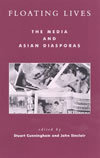 |
 |
 |
 |
![]()
Volume 6,
Issue 1,
Fall 2002
|
Floating Lives: The Media and Asian Diasporas Cunningham, Stuart and Sinclair, John (Eds.).Rowman and Littlefield Publishers Inc., 2002 236 pages |

|
Reviewed by: De
Vries, Kimberly M., Massachusetts Institute
of Technology
Printer-friendly PDF
version
As scholars have explored the dynamics
of globalization in recent years, increasing attention has been paid to
the way diasporic communities construct identity. In particular, diasporic
Asian communities have been studied on a large scale in terms of their
economic power, for example, or on a very personal level in the work of
scholars like Ien Ang who use their own experiences as a frame for the
discussion (1). The contributors to Floating Lives: The Media and
Asian Diasporas take an intermediate approach by studying small groups
of people within several Asian communities of Australia. They
offer a valuable perspective on the functioning of diasporic communities
and the way television and film are used in identity formation.
The book starts with a chapter by the editors, who lay out the terms and
the scope of these projects, as well as contextualize the studies with
an overview of Australian history and policy around immigration. The remaining
chapters detail studies of Chinese, Vietnamese, Fiji Indian, and Thai
communities in Australia, each taking the multi-layered approach outlined
in Chapter One.
Unlike many existing studies of the ways film and television construct
ethnic identity, these researchers have deliberately chosen to focus on
how audiences use visual media for their own purposes to meet their own
needs. Additionally, the authors question the extent to which cultures
can be neatly divided along ethnic lines or power relations, arguing that
immigrant and host communities intermingle and alter each other in a constantly
shifting negotiation. This collection allows readers to see important
connections between the personal circumstances of the subjects, and the
larger Australian context, and also to notice the way different groups
of immigrants, such as Chinese and Vietnamese, are connected by their
media consumption.
The researchers provide thick description of their subjects with a combination
of surveys, observations and interviews that capture both the specifics
of class status, educational levels, motives for immigration, etc, and
reveal how these factors change the manner in which television and film
are used. For example, in the chapter titled "Bollywood Down Under,"
Manas Ray explores how the terms of migration, economic or exhilic, are
reflected in the attitudes toward media from the home culture as a way
to maintain old national ties or to maintain culture while creating new
national ties.
For all the detailed description and contextualization, the authors do
fall somewhat short of their promise in two ways. First, although the
focus is on television and film, some reference to the effects of the
internet would be helpful—either to illustrate how these media interact,
or to explain why they don't. This absence was suprising considering the
extent to which online diasporic communities have garnered attention in
recent years. For example, Huaren.Org
has
helped to create a global identity for Chinese around the world.
Second, while the first chapter gives a thorough introduction to
the issues under discussion, the lack of a conclusion is disappointing;
bringing all of these studies together would show that they are not only
instructive in themselves, but in relation to each other.
However, the interest of the studies far outweighs these deficiencies.
Floating Lives stands as a valuable resource for scholars investigating
diasporic communities by offering concrete cases that examine how theories
about diaspora may or may not play out in the real lives of migrants.
Studies of cedia and diaspora are often grouped by ethnicity, so that interested readers can find more information by visiting the websites of, for example, Chinese communication scholarly organizations like the Association of Chinese Communication Studies. Conference websites can also be a good source of information, such as for the recent Media in Transition 2 conference held at MIT, which had a special focus on Globalization and Asia this year, and provides links to all the papers in pdf. format.
1.Ang recently published a book that explores the intersection of theory and personal experience, On Not Speaking Chinese: Living Between Asia and the West. Some of her work can be seen online at Mots Pluriels.
Back to Top
Home | Current
Issue | Archives | Editorial
Information | Search | Interact